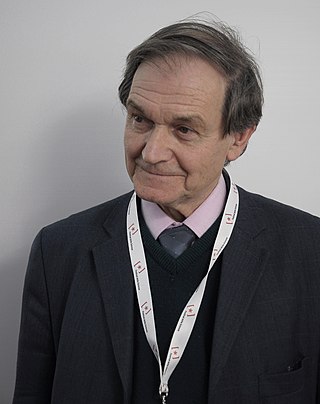罗杰·彭罗斯
英國數學物理學家,休閒數學家和哲學家 来自维基百科,自由的百科全书
罗杰·彭罗斯爵士,功绩勋章(英国),英国皇家学会(英语:Sir Roger Penrose,1931年8月8日—),英国数学家,数学物理学家,科学哲学家与诺贝尔物理学奖获得者. 他是牛津大学的劳斯·鲍尔数学名誉教授。他在数学物理方面的研究拥有高度评价,特别是对广义相对论与宇宙学方面的贡献。罗杰·彭罗斯是科学家莱昂内尔·彭罗斯与玛格丽特·利斯的儿子,为数学家奥利弗·彭罗斯与西洋棋大师乔纳森·彭罗斯的兄弟。
| 罗杰·彭罗斯 Roger Penrose | |
|---|---|
 彭罗斯,摄于2011年 | |
| 出生 | 1931年8月8日 |
| 居住地 | |
| 国籍 | |
| 母校 | 伦敦大学学院 剑桥大学圣约翰学院 |
| 知名于 | 扭量理论 时空几何 宇宙审查 穆尔-彭罗斯广义逆 彭罗斯-霍金奇点定理 彭罗斯铺砌 潘洛斯阶梯 |
| 奖项 | 沃尔夫奖(1988 年) 狄拉克奖章(1989 年) 德摩根奖章(2004年) 科普利奖章(2008 年) 诺贝尔物理学奖(2020 年) |
| 科学生涯 | |
| 研究领域 | 数学物理 数学科学 |
| 机构 | 伦敦大学贝德福德学院 剑桥大学圣约翰学院 普林斯顿大学 雪城大学 伦敦国王学院 伦敦大学柏贝克学院 牛津大学 |
| 博士导师 | 约翰·托德(John A. Todd) |
| 著名学生 |
|
| 受影响自 | 丹尼斯·夏玛(Dennis Sciama) |
| 施影响于 | 米高·阿蒂亚 |
早期生活和教育
罗杰·彭罗斯生于英格兰埃塞克斯的科尔切斯特,是玛格丽特·利斯(Margaret Leathes)与精神病学家和遗传学家莱昂内尔·彭罗斯(Lionel Penrose)的儿子。
彭罗斯小时候在加拿大度过了第二次世界大战,父亲在加拿大安大略省伦敦工作[2]。彭罗斯曾就读于 University College School 和伦敦大学学院,并在那里获得了数学的一等学位。
研究


1955年,彭罗斯在他还是学生之时重新引入了广义逆矩阵(又称作穆尔-彭罗斯广义逆)[3]。
1958年,彭罗斯在剑桥大学于知名代数学家与几何学家约翰·托德(John A. Todd)指导下获得博士学位;其博士论文题目为《代数几何学中的张量方法》(Tensor methods in algebraic geometry)。1965 年,彭罗斯与物理学家史蒂芬·霍金在剑桥大学证明了奇点(例如黑洞)可以从毁坏中的巨星体的重力塌缩现象中形成。[4]
1967年,彭罗斯发明了扭量理论,将闵可夫斯基空间中的几何物体映射到四维复空间,此空间度量标记为(2,2)。1969年,他推测出宇宙审查假说,这项提案指出了宇宙阻挡我们了解奇点(例如黑洞)内禀的不可预测性,以其被遮掩在我们视线之外。这个形式现在称作弱审查假说;1979年,彭罗斯建构了更强的形式,称作强审查假说。加上BKL猜想与非线性稳定性问题,使得审查猜想成为广义相对论中最重要的未决问题之一。
罗杰·彭罗斯1974年发现了著名的彭罗斯铺砌,能以两种砖片非周期性地铺满整个平面。这种排列形式于1984年在准晶体中的原子排列中被发现。另一个重要的贡献是他在1971年发明了自旋网路,尔后在回圈量子重力理论中成为构成时空几何的基础。他在推广通称为彭罗斯图的因果图(causal graph)颇具影响力。
1983年,当时的教务长比尔·戈登(Bill Gordon)邀请彭罗斯在休斯敦的莱斯大学(Rice University)任教。从1983年到1987年,他在那里工作[5]。
后来的活动
2004年,彭罗斯发表了《接近真实:宇宙法则导引》(The Road to Reality: A Complete Guide to the Laws of the Universe),是一本1,099页的书籍,目标在于对物理定律给予详尽的指导。
物理与意识

彭罗斯撰写了探讨基础物理与人类(或者动物)意识之间联系的一些书籍。在《皇帝新脑》(1989)一书中,他声称已知的物理定律不足以解释意识现象。彭罗斯提议新的物理学所具有的特性应该能填补经典物理学和量子力学之间的理论沟壑(他本人称之为正确的量子引力理论)。彭罗斯使用图灵停机问题的变体来说明一个确定性的系统并不需要一定是图灵可计算的(从算法角度讲可进行有效计算的)(比如,考虑只有 ON 和 OFF 两个状态的机器,当给定的图灵机停机时,系统状态被置为 ON;当图灵机运行时,系统则被置为 OFF。如此,系统状态将完全取决于图灵机本身。但是并没有算法上可行的方法来确定图灵机是否停机)。
彭罗斯相信这种确定性和非算法性共存的过程可能在量子力学的波函数坍缩中起到作用,这个过程甚至可能被大脑驾驭。他认为作为一种算法确定性的系统,当前的电子计算机无法产生智能。他反对认为大脑的推理过程是完全的图灵可计算的观点(若此则大脑可被足够复杂的电子计算机复制)。彭罗斯的这方面观点与强人工智能支持者的观点相左,后者认为思维可用算法模拟。为了驳斥后者的观点,彭罗斯声称意识是超越数理逻辑的,因为诸如停机问题的不可解性质和哥德尔不完备定理导致基于算法的逻辑系统不能产生具有人类智能特性的智能(比如,对数学的洞见)。这些说法最早得到了牛津大学莫顿学院的哲学家约翰·卢卡斯(John Lucas)的支持。
彭罗斯和卢卡斯关于哥德尔不完备定理在人类智能的计算理论方面所具有的含义的观点受到了来自数学家,计算机科学家和哲学家的批评。上述领域的专家们一致认为彭罗斯/卢卡斯的观点是不成立的, 但不同领域的专家会从不同的方面进行批评[7]。来自马文·闵斯基(人工智能的主要支持者)的批评尤其激烈:彭罗斯“一章接一章的试图说明人类意识不能基于任何已知的科学原理。”闵斯基的立场与此完全相反——他相信本质上来说人类就是机器:虽然这种机器的功能很复杂,但使用现有的物理学是完全可解释的。闵斯基如此评价彭罗斯:“仅靠寻找新的基本原理而不攻关真实的细节可能会把科学的探索带得太超前。但在我看来,这就是彭罗斯的探索。”[8]
作为对《皇帝新脑》所受到的负面评价的回应,彭罗斯随后出版了《意识的阴影》(Shadows of the Mind, 1994)和《庞大,渺小,及人类意识》(The Large, the Small and the Human Mind, 1997)。在这些书中,他还引用了来自麻醉专家史都华·哈默洛夫的观察。
彭罗斯和史都华·哈默洛夫认为意识是微管中量子引力效应的结果。该过程被他们称为 协调客观还原(orchestrated objective reduction)。此后,在《物理评论E》上,马克斯·泰格马克发文指出,微管中神经元激发和兴奋的时间尺度以最少 10,000,000,000 倍的因子慢于量子退相干时间。[9]这个支持泰格马克的申明总结了这篇文章的接受程度:“没有卷入这场争论的物理学家们,比如 IBM 的 Jone A. Smolin 认为文中的计算确认了长久以来的怀疑。‘我们拥有的并不是一颗接近绝对零度的大脑。人类大脑合理地不大可能以量子方式进化’”。[10]泰格马克的论文被彭罗斯-哈默洛夫的批评者们广泛引用。
物理学家 Scott Hagan、Jack Tuszynski 和史都华·哈默洛夫也在《物理评论E》上发文回应马克斯·泰格马克[11],声称马克斯·泰格马克检验的并不是 协调客观还原 模型,而是他自己构造的模型:马克斯·泰格马克的计算中涉及的量子叠加态(the superpositions of quanta)以24纳米分隔,而非协调客观还原所要求的小的多的分隔。按照协调客观还原规定的量子叠加态进行运算之后,史都华·哈默洛夫的团队宣布新的量子退相干所需的时间尺度要比马克斯·泰格马克的结果大7个级数。但这个结果依然比所需的时间少了25毫秒——如果想要使量子过程如同协调客观还原所描述的那样,能够和40赫兹的伽玛同步产生关联的话。为了弥补这一环节,史都华·哈默洛夫等人做了一系列假设和提议。首先他们假设微管内部可以在液态和凝胶态之间互相转换。在凝胶状态下,他们进一步假设水的电偶极子会沿着微管外围的微管蛋白同向排列。史都华·哈默洛夫认为这种有序排列的水将会屏蔽微管蛋白中任何量子退相干过程。每个微管蛋白还会从微管中延伸出一条带负电荷的“尾巴”,从而可以吸引带正电荷的离子。这可以进一步屏蔽量子退相干的过程。除此之外,还有推测认为微管可在生物能的驱使下进入相干态。

最终,有建议认为微管的构造或许适用于量子纠错(quantum error correction),一种可将量子相干性和环境交互能力结合起来的手段。在最近的十年里,一些同情彭罗斯的研究者提出了若干适用于微管量子过程的替代方案。这些方案认为微管蛋白的“尾巴”可以和微管相关的蛋白质(motor proteins和presynaptic scaffold proteins)发生作用。这些提议的优势在于可在马克斯·泰格马克的量子退相干时间尺度内发生。
史都华·哈默洛夫在 Google Tech 关于量子生物学的系列讲座中给出了该领域近期研究的总结,结果再次招致对协调客观还原模型的批评。[12]除此之外,彭罗斯和史都华·哈默洛夫在一篇发表于2011年的论文中,参考之前所受到的批评,给出了协调客观还原理论的修改模型;该论文还探讨了意识在宇宙中占有的地位。[13]
尽管作为彭罗斯观点的支持者,Phillip Tetlow 承认彭罗斯关于人类意识过程的看法现在在科学界属于“少数派观点”,引用了闵斯基的批评且摘引了科学专栏记者查尔斯·塞费(Charles Seife)的将彭罗斯作为“少数相信意识的本质意味着量子过程的科学家之一”的描述[10]。
2014年1月,史都华·哈默洛夫和彭罗斯试探地提出,日本物质材料研究中心的博士 Anirban Bandyopadhyay 所发现的微管中的量子振荡证实了协调客观还原假说。[14][15]这个理论的修订更正版伴随著批评和辩论发表在《Physics of Life Reviews》。[16]
宗教信仰
彭罗斯是一个无神论者。[17][18]在纪录片时间简史(A Brief History of Time)中,彭罗斯说道:
“我认为宇宙是有目的的,它的出现不可能是机缘巧合……有些人认为宇宙就是会存在,而且就是会运转——有点类似某种计算过程,然后我们不知道怎么的,就意外出现在宇宙中。但是我认为在看待宇宙的问题上,这些看法并不具有建设意义,我认为关于宇宙一定有什么更深刻的东西。”[19]
彭罗斯还是英国人道协会(Humanists UK)的杰出支持者。
获奖

罗杰·彭罗斯因对科学的贡献获颁多个奖项。
著作
- Penrose. Techniques of Differential Topology in Relativity. Society for Industrial & Applied Mathematics. 1972. ISBN 978-0-89871-005-2. (rare)
- Penrose, Roger; Rindler, Wolfgang. Spinors and Space-Time: Volume 1, Two-Spinor Calculus and Relativistic Fields. Cambridge University Press. 1987 (reprint). ISBN 978-0-521-33707-6. (paperback)
- Penrose, Roger; Rindler, Wolfgang. Spinors and Space-Time: Volume 2, Spinor and Twistor Methods in Space-Time Geometry. Cambridge University Press. 1988 (reprint). ISBN 978-0-521-34786-0. (paperback)
- Penrose. The Emperor's New Mind: Concerning Computers, Minds, and The Laws of Physics. Oxford University Press. 1989. ISBN 978-0-14-014534-2. (paperback)
- Penrose. Shadows of the Mind: A Search for the Missing Science of Consciousness. Oxford University Press. 1994. ISBN 978-0-19-853978-0. (hardback)
- Hawking, Stehpen; Penrose, Roger. The Nature of Space and Time. Princeton University Press. 1996. ISBN 978-0-691-03791-2. (hardback) ISBN 978-0-691-05084-3 (paperback).
- Penrose, Roger; Shimony, Abner; Cartwright, Nancy; Hawking, Stephen. The Large, the Small, and the Human Mind. Cambridge University Press. 1997. ISBN 978-0-521-56330-7. (hardback), ISBN 978-0-521-65538-5 (paperback), Canto edition: ISBN 978-0-521-78572-3.
- Penrose. The Road to Reality: A Complete Guide to the Laws of the Universe. London: Jonathan Cape. 2004. ISBN 978-0-224-04447-9. (hardcover), ISBN 978-0-09-944068-0 (paperback).
相关条目
注释
参考文献
延伸阅读
外部链接
Wikiwand - on
Seamless Wikipedia browsing. On steroids.


